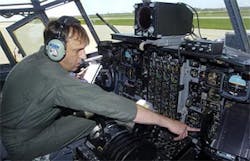Youngstown-Warren Airport Jeopardized by Ohio Air Base Closure
There's even more at stake than military jobs for some communities when the Pentagon announces its base closing recommendations Friday.
The loss of the air base near Warren, Ohio, would compromise the ability to operate the already struggling Youngstown-Warren Regional Airport.
Warren Mayor Michael O'Brien said the airport is dependent on the Youngstown Air Reserve Station, home to the 910th Airlift Wing, which operates C-130 cargo and personnel carriers.
It would be difficult to keep the airport open without the air base, he said.
''The area is depressed presently,'' O'Brien said. ''It would be absolutely devastating to the area.''
Bill Oliver, a consultant with The Boyd Group, an Evergreen, Colo.-based aviation consulting firm, said airports are commonly used by both military and civilian aircraft. He said any airport that loses an air base will be hurting.
''The city and civilian airport is going to be faced with picking up the tab,'' Oliver said. ''They'll have to make up the revenue. It's like losing a major tenant or partner.''
The Defense Department plans to shut down up to 25 percent of the nation's 425 military bases to save $3 billion annually. The department is determining which bases contribute most to the nation's military readiness.
The department declined comment on how small airports would be affected.
''We're not going into any speculation at all,'' spokesman Glenn Flood said. ''We just don't know.''
The air base at Youngstown-Warren Regional Airport employs 2,400 full and part-time workers and accounts for hundreds of spinoff jobs for an overall annual impact of $120 million.
It accounts for half of the air traffic at the airport, which hasn't had scheduled passenger air service since Northwest Airlines ended service there in 2002. Now, charter flights, private planes and corporate jets make up most of the civilian traffic.
U.S. Rep. Tim Ryan, D-Ohio, has made the base his top priority. In late 2003, he created a group called Save Our Airbase Reservists, SOAR, to analyze ways of improving the air base's status with the Pentagon.
SOAR co-chairman Reid Dulberger said the group provided the Pentagon with a plan for possible military expansion at the air base. SOAR also created a zoning board to keep development from encroaching on the airport, which is another important issue for the military.
''We have done everything we could locally do to survive this round of base realignment and closure,'' Dulberger said.
The loss of the air base would cause several budgetary problems.
It would force the airport to provide its own fire rescue service, Dulberger said. Also, Mahoning and Trumbull counties would no longer be permitted under state law to contribute a combined $500,000 a year in hotel bed taxes to cover the airport's losses.
Likewise, Springfield Municipal Airport would have to change its operations if the base that's home to the Air National Guard 178th Fighter Wing were to close.
''I don't know that the airport would close, but it would have a major impact on us,'' said Jim Bodenmiller, assistant city manager for Springfield in southwest Ohio.
The 178th Fighter Wing, which trains future fighter pilots in F-16s, accounts for about two-thirds of the air traffic at the Springfield airport.
''Obviously, the base is the biggest user,'' Bodenmiller said. ''It's through their investment that we've been able to make the majority of improvements at the airport.''
In the past 10 years, there have been $70 million in improvements to the airport, $40 million of which was from federal military construction money.
___
Associated Press Writer James Hannah in Dayton contributed to this story.
